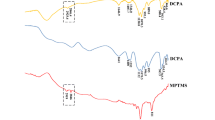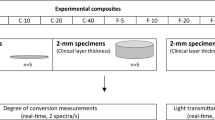Abstract
Objectives
This study investigated light transmittance and polymerization kinetics of experimental remineralizing composite materials based on amorphous calcium phosphate (ACP), reinforced with inert fillers.
Materials and methods
Light-curable composites were composed of Bis-EMA-TEGDMA-HEMA resin and ACP, barium glass, and silica fillers. Additionally, a commercial composite Tetric EvoCeram was used as a reference. Light transmittance was recorded in real-time during curing, and transmittance curves were used to assess polymerization kinetics. To obtain additional information on polymerization kinetics, temperature rise was monitored in real-time during curing and degree of conversion was measured immediately and 24 h post-cure.
Results
Light transmittance values of 2-mm thick samples of uncured ACP composites (2.3–2.9 %) were significantly lower than those of the commercial composite (3.8 %). The ACP composites presented a considerable transmittance rise during curing, resulting in post-cure transmittance values similar to or higher than those of the commercial composite (5.5–7.9 vs. 5.4 %). The initial part of light transmittance curves of experimental composites showed a linear rise that lasted for 7–20 s. Linear fitting was performed to obtain a function whose slope was assessed as a measure of polymerization rate. Comparison of transmittance and temperature curves showed that the linear transmittance rise lasted throughout the most part of the pre-vitrification period.
Conclusions
The linear rise of light transmittance during curing has not been reported in previous studies and may indicate a unique kinetic behavior, characterized by a long period of nearly constant polymerization rate.
Clinical relevance
The observed kinetic behavior may result in slower development of polymerization shrinkage stress but also inferior mechanical properties.






Similar content being viewed by others
References
Skrtic D, Antonucci JM, Eanes ED (2003) Amorphous calcium phosphate-based bioactive polymeric composites for mineralized tissue regeneration. J Res Natl Inst Stand Technol 108(3):167–182
Li F, Wang P, Weir MD, Fouad AF, Xu HH (2014) Evaluation of antibacterial and remineralizing nanocomposite and adhesive in rat tooth cavity model. Acta Biomater 10(6):2804–2813. doi:10.1016/j.actbio.2014.02.033
Weir MD, Chow LC, Xu HH (2012) Remineralization of demineralized enamel via calcium phosphate nanocomposite. J Dent Res 91(10):979–984. doi:10.1177/0022034512458288
Skrtic D, Antonucci JM (2007) Dental composites based on amorphous calcium phosphate—resin composition/physicochemical properties study. J Biomater Appl 21(4):375–393. doi:10.1177/0885328206064823
Marovic D, Tarle Z, Hiller KA, Muller R, Ristic M, Rosentritt M, Skrtic D, Schmalz G (2014) Effect of silanized nanosilica addition on remineralizing and mechanical properties of experimental composite materials with amorphous calcium phosphate. Clin Oral Investig 18(3):783–792. doi:10.1007/s00784-013-1044-x
Marovic D, Tarle Z, Hiller KA, Muller R, Rosentritt M, Skrtic D, Schmalz G (2014) Reinforcement of experimental composite materials based on amorphous calcium phosphate with inert fillers. Dent Mater 30(9):1052–1060. doi:10.1016/j.dental.2014.06.001
Marovic D, Tarle Z, Ristic M, Music S, Skrtic D, Hiller KA, Schmalz G (2011) Influence of different types of fillers on the degree of conversion of ACP composite resins. Acta Stomatol Croat 45:231–238
Xu HH, Weir MD, Sun L, Moreau JL, Takagi S, Chow LC, Antonucci JM (2010) Strong nanocomposites with Ca, PO4, and F release for caries inhibition. J Dent Res 89(1):19–28. doi:10.1177/0022034509351969
Kawaguchi M, Fukushima T, Miyazaki K (1994) The relationship between cure depth and transmission coefficient of visible-light-activated resin composites. J Dent Res 73(2):516–521. doi:10.1177/00220345940730020601
Howard B, Wilson ND, Newman SM, Pfeifer CS, Stansbury JW (2010) Relationships between conversion, temperature and optical properties during composite photopolymerization. Acta Biomater 6(6):2053–2059. doi:10.1016/j.actbio.2009.11.006
Musanje L, Darvell BW (2006) Curing-light attenuation in filled-resin restorative materials. Dent Mater 22(9):804–817. doi:10.1016/j.dental.2005.11.009
Shibayama M, Ozeki S, Norisuye T (2005) Real-time dynamic light scattering on gelation and vitrification. Polymer 46(7):2381–2388. doi:10.1016/j.polymer.2005.01.018
Seghi RR, Gritz MD, Kim J (1990) Colorimetric changes in composites resulting from visible-light-initiated polymerization. Dent Mater 6(2):133–137. doi:10.1016/S0109-5641(05)80044-2
Harrington E, Wilson HJ, Shortall AC (1996) Light-activated restorative materials: a method of determining effective radiation times. J Oral Rehabil 23(3):210–218. doi:10.1111/j.1365-2842.1996.tb01235.x
Ogunyinka A, Palin WM, Shortall AC, Marquis PM (2007) Photoinitiation chemistry affects light transmission and degree of conversion of curing experimental dental resin composites. Dent Mater 23(7):807–813. doi:10.1016/j.dental.2006.06.016
Fujita K, Ikemi T, Nishiyama N (2011) Effects of particle size of silica filler on polymerization conversion in a light-curing resin composite. Dent Mater 27(11):1079–1085. doi:10.1016/j.dental.2011.07.010
Shortall AC, Palin WM, Burtscher P (2008) Refractive index mismatch and monomer reactivity influence composite curing depth. J Dent Res 87(1):84–88. doi:10.1177/154405910808700115
Rosentritt M, Shortall AC, Palin WM (2010) Dynamic monitoring of curing photoactive resins: a methods comparison. Dent Mater 26(6):565–570. doi:10.1016/j.dental.2010.02.006
Ilie N, Durner J (2014) Polymerization kinetic calculations in dental composites: a method comparison analysis. Clin Oral Investig 18(6):1587–1596. doi:10.1007/s00784-013-1128-7
Andrzejewska E (2001) Photopolymerization kinetics of multifunctional monomers. Prog Polym Sci 26(4):605–665. doi:10.1016/S0079-6700(01)00004-1
Par M, Gamulin O, Marovic D, Skenderovic H, Klaric E, Tarle Z (2016) Conversion and temperature rise of remineralizing composites reinforced with inert fillers. J Dent. doi:10.1016/j.jdent.2016.03.008
Emami N, Sjodahl M, Soderholm KJ (2005) How filler properties, filler fraction, sample thickness and light source affect light attenuation in particulate filled resin composites. Dent Mater 21(8):721–730. doi:10.1016/j.dental.2005.01.002
Atai M, Motevasselian F (2009) Temperature rise and degree of photopolymerization conversion of nanocomposites and conventional dental composites. Clin Oral Investig 13(3):309–316. doi:10.1007/s00784-008-0236-2
Clewell DH (1941) Scattering of light by pigment particles. J Opt Soc Am 31:512–517. doi:10.1364/JOSA.31.000521
Pilo R, Cardash HS (1992) Post-irradiation polymerization of different anterior and posterior visible light-activated resin composites. Dent Mater 8(5):299–304. doi:10.1016/0109-5641(92)90104-K
Dickens SH, Stansbury JW, Choi KM, Floyd CJE (2003) Photopolymerization kinetics of methacrylate dental resins. Macromolecules 36(16):6043–6053. doi:10.1021/ma021675k
Moraes RR, Garcia JW, Barros MD, Lewis SH, Pfeifer CS, Liu J, Stansbury JW (2011) Control of polymerization shrinkage and stress in nanogel-modified monomer and composite materials. Dent Mater 27(6):509–519. doi:10.1016/j.dental.2011.01.006
Beun S, Bailly C, Dabin A, Vreven J, Devaux J, Leloup G (2009) Rheological properties of experimental Bis-GMA/TEGDMA flowable resin composites with various macrofiller/microfiller ratio. Dent Mater 25(2):198–205. doi:10.1016/j.dental.2008.06.001
Hadis M, Leprince JG, Shortall AC, Devaux J, Leloup G, Palin WM (2011) High irradiance curing and anomalies of exposure reciprocity law in resin-based materials. J Dent 39(8):549–557. doi:10.1016/j.jdent.2011.05.007
Berriot J, Lequeux F, Monnerie L, Montes H, Long D, Sotta P (2002) Filler–elastomer interaction in model filled rubbers, a 1H NMR study. J Non-Cryst Solids 307-310:719–724. doi:10.1016/S0022-3093(02)01552-1
Ou YC, Yu ZZ, Vidal A, Donnet JB (1996) Effects of alkylation of silicas on interfacial interaction and molecular motions between silicas and rubbers. J Appl Polym Sci 59(8):1321–1328. doi:10.1002/(SICI)1097-4628(19960222)59:8<1321::AID-APP16>3.0.CO;2-8
Wilson KS, Zhang K, Antonucci JM (2005) Systematic variation of interfacial phase reactivity in dental nanocomposites. Biomaterials 26(25):5095–5103. doi:10.1016/j.biomaterials.2005.01.008
Ferracane JL, Berge HX, Condon JR (1998) In vitro aging of dental composites in water—effect of degree of conversion, filler volume, and filler/matrix coupling. J Biomed Mater Res 42(3):465–472. doi:10.1002/(SICI)1097-4636(19981205)42:3<465::AID-JBM17>3.0.CO;2-F
Ilie N, Hickel R (2009) Investigations on mechanical behaviour of dental composites. Clin Oral Investig 13(4):427–438. doi:10.1007/s00784-009-0258-4
Skrtic D, Antonucci JM (2011) Bioactive polymeric composites for tooth mineral regeneration: physicochemical and cellular aspects. J Funct Biomater 2(3):271–307. doi:10.3390/jfb2030271
Skrtic D, Antonucci JM, Liu DW (2006) Ethoxylated bisphenol dimethacrylate-based amorphous calcium phosphate composites. Acta Biomater 2(1):85–94. doi:10.1016/j.actbio.2005.10.004
Tarle Z, Knežević A, Matošević D, Škrtić D, Ristić M, Prskalo K, Musić S (2009) Degree of vinyl conversion in experimental amorphous calcium phosphate composites. J Mol Struct 924-926:161–165. doi:10.1016/j.molstruc.2008.11.024
Watts DC (2005) Reaction kinetics and mechanics in photo-polymerised networks. Dent Mater 21(1):27–35. doi:10.1016/j.dental.2004.10.003
Steinhaus J, Hausnerova B, Haenel T, Grossgarten M, Moginger B (2014) Curing kinetics of visible light curing dental resin composites investigated by dielectric analysis (DEA). Dent Mater 30(3):372–380. doi:10.1016/j.dental.2013.12.013
Acknowledgments
We thank Mira Ristić and Marijan Marciuš from the Division of Materials Chemistry, Ruđer Bošković Institute, for the SEM micrographs. We also gratefully acknowledge Drago Skrtic for providing us with the zirconia-hybridized ACP.
Author information
Authors and Affiliations
Corresponding author
Ethics declarations
Conflict of interest
The authors declare that they have no conflict of interest.
Funding
This investigation was supported by Croatian Science Foundation (Project 08/31 Evaluation of new bioactive materials and procedures in restorative dental medicine).
Ethical approval
This article does not contain any studies with human participants or animals performed by any of the authors.
Informed consent
For this type of study, formal consent is not required.
Rights and permissions
About this article
Cite this article
Par, M., Marovic, D., Skenderovic, H. et al. Light transmittance and polymerization kinetics of amorphous calcium phosphate composites. Clin Oral Invest 21, 1173–1182 (2017). https://doi.org/10.1007/s00784-016-1880-6
Received:
Accepted:
Published:
Issue Date:
DOI: https://doi.org/10.1007/s00784-016-1880-6




